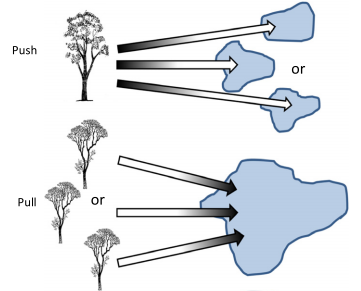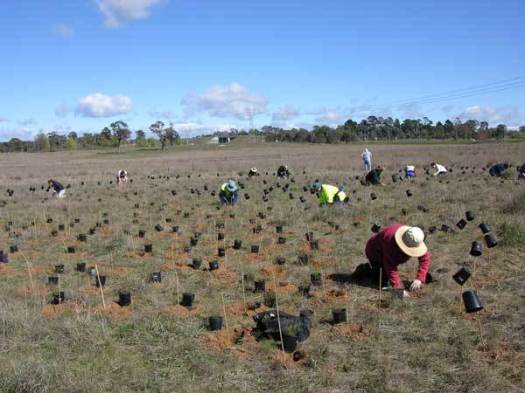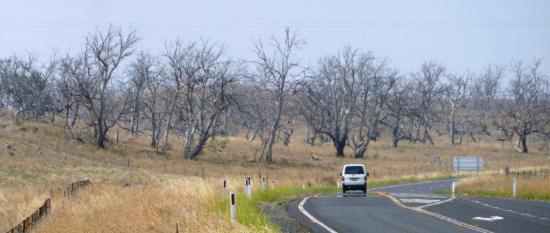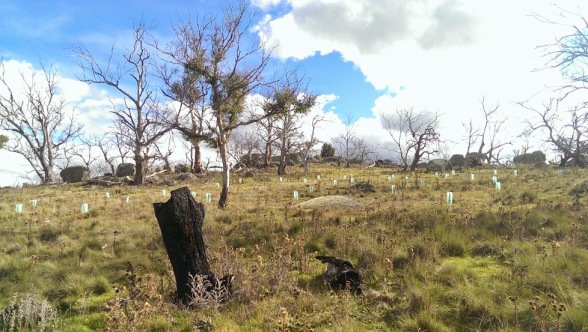Assisted migration can be an expensive and risky way to save a species that is threatened by climate change – but what if we could use it to save whole ecosystems by replacing lost keystone species?
As climatic regions shift with climate change, animals and plants are being forced to migrate into new areas as their old habitat becomes unsuitable. Some species will be able to keep up with the rate of change, but others will be left behind; especially those that move slowly or already have limited distributions. Natural migration may also be limited by natural barriers such as a mountain range, an ocean, or a different soil type, or by artificial barriers like roads or cities.
Another consequence of shifting climatic regions is that as species start to move they will disappear from some areas, leaving a ‘gap’. This is particularly concerning for dominant or ‘keystone’ species that play an important role in ecosystem functioning. Although the particular species is not at risk of extinction, a localised extinction may have many negative consequences for other species and the ecosystem as a whole.
Push and Pull – risks and benefits
In certain cases human intervention may be required to create new populations, in order to ensure the survival of threatened species or ecosystems. This is known variously as assisted migration, assisted colonisation, managed relocation, etc. In a recent review, Lunt et al. (2013) recognised two different methods which they named ‘push’ and ‘pull’ migration.

‘Push’ migration is well established as a method of saving threatened species that may be unable to keep pace with the rate of climate change, and would most likely become extinct without human intervention. It involves removing some individuals and creating new populations in more suitable habitat. This method is also used to create ‘insurance’ populations – for example by establishing a population of threatened birds on a predator-free island, or to reduce the risk of catastrophic events like a fire or disease wiping out a whole species in one go. However these relocations are expensive and risky – for small populations failure could mean not only losing a few individuals but also reducing the viability of the original population, or there could be negative effects on the ecosystem they are being moved to.

On the other hand, ‘pull’ migration refers to introducing one or more species to fill the ‘gap’ created by a missing keystone species. In this case, while there is still a risk of negative effects, the benefit of maintaining an entire ecosystem (rather than just one species) may far outweigh the risks.
The Monaro dieback
In a previous post, I suggested that assisted migration could be used to replace a species of eucalypt (Eucalyptus viminalis or Manna Gum) that is disappearing from the Monaro region in south east NSW where it was previously dominant. This may be one of the first examples where a keystone species has been lost due to climate change, and we are faced with the question of what to do about it (for the whole story, check out my previous posts on the Monaro dieback).

Some people I have spoken to have suggested that we should do nothing – simply let nature take its course and something will naturally fill in the gap*. Well, something almost certainly will fill the gap, but will it really be a replacement? More likely the loss of this keystone species will allow weeds to invade and spread – particularly grassy weeds like African Lovegrass which is already a huge problem and likely to cause further damage to the ecosystem.
Manna Gums are widespread across eastern Australia so they are not at risk of extinction, but they do play an important role as the dominant overstorey species. The Monaro is a harsh landscape, and trees provide a range of benefits for the environment and production, such as shade and shelter for stock, reducing erosion, and habitat for native species. Landholders and organisations such as Landcare and Greening Australia invest large amounts of money in planting trees; if the Manna Gums are no longer going to survive, what species should we use to replace it?

Which species should we use?
If we were to try to replace the missing Manna gums with another species of eucalypt, there are a few questions we need to ask when making our selection:
- Which species are likely to survive in the current climate, and also the predicted climate in 50 or 100 years’ time?
- Which species are unlikely to become pests or disrupt ecosystem processes in their new location?
- Which species will replace the ecosystem services and values that have been lost?
To answer the first question, we can look at models predicting the future climate for the area. We can then look for a region that has a similar climate now and see what species grow well there. We might also look at what other species already growing in the area but are displaying more resilience – perhaps they are more tolerant of high temperatures, or less susceptible to insect attack?
Unfortunately, many of the characteristics that make species successful at surviving and reproducing under harsh conditions also make them prone to becoming invasive. History has taught us that species introductions are always risky, and we need to be very careful that our interventions don’t have unintended consequences. In a highly modified landscape like the Monaro, the risks of introducing an exotic species are far less than if we were proposing to introduce a threatened species into a relatively intact ecosystem.
The last question is more complicated than it seems, because it’s not always clear what has been lost, or whether we are aiming for conservation of the ecosystem that was there originally, or focussing more on function. Are we looking for a tree that provides habitat for a certain species e.g. Koala (for which Manna Gums are one of very few preferred hosts); or would we be happy with any tree species that will provide services like shade, hollows, or soil stabilisation.
A positive note
Assisted migration is a contentious issue, and given our limited resources it is very important to accurately weigh up the risks and benefits. While ‘push’ migration may be a useful tool in many cases, the focus on one method means we could be underestimating the possible benefits, or overstating the risks. Unfortunately, this is no longer a hypothetical argument; the Monaro dieback is a scary reminder that climate change is happening now, but also presents an opportunity to explore possible options that could help us deal with similar situations in the future.
*An afterthought…on playing God
It is all too easy to shy away from actions or interventions that feel like ‘playing god’ – after all, what right do we have to decide where species should live, or whether they should survive at all? But it seems to me that inaction – letting nature ‘take its course’ – is not really an option. The reality is that our actions have and will lead to species extinctions and loss of ecosystem functions, and maintaining these values will require significant human intervention.
References:
Lunt I. D., Byrne M., Hellmann J. J. et al. (2013) Using assisted colonisation to conserve biodiversity and restore ecosystemm function under climate change. Biol. Conserv. 157, 172–7.

February 12, 2015 at 9:55 am
Ms Ross, a very thoughtful essay, which certainly requires considered responses. Just one note, however, to start. I know that while Manna Gums certainly do form an important component of the Koala’s diet, it certainly is not one of the “few preferred hosts”. Koalas eat leaves of many different eucalypt species – in fact they need to switch to avoid poisoning themselves at certain times of the year. They also eat, amongst others,leaves of pines and casuarinas. And in the eastern parts of the Monaro, they are known to eat bark too.
A response to your question. Those who think that nature should take its course are ignoring that we humans are indeed part of nature. We created the problem, it is now our responsibility to fix it. I think we need to think of the solution in terms of an experiment. Rather than focus on which keystone species we need to use to replace the graveyard Manna Gums, I would suggest that we try multiple species and monitor the results There are a plethora of local species that would fill the bill. Yellow Box and Apple Box are two obvious contenders. And I would urge the use of multiple acacias in any rehabilitation attempts. Rebuilding an ecosystem would mean more than just replacing one tree with another. That would seem a high risk strategy to me.
Really enjoying your blog.
Cheers, Rainer
LikeLike
February 13, 2015 at 6:11 am
Thanks for your comment Rainer. I absolutely agree that we should be trialing many species in rehabilitation sites, including both local species but also possibly from further afield. I was certainly not suggesting that one species could simply fill the gap.
I have had some reports that in some areas Apple Box is starting to be affected as well – whether it is the same problem or something different entirely I don’t know. But it makes sense not to put all your eggs in one basket, and the more diverse the better. A diverse understorey is of course also very important, although as I have said even areas with an intact understorey are suffering from dieback.
Greening Australia always includes a diverse range of over- and understorey species in their plantings, based on the species that occur naturally in the region. Previously, when choosing species for the Monaro region, E. viminalis was always first on the list. But the question is do we just move Manna Gums down that list and increase the percentage of other local species, or should we be preparing for the future climate by trialing species that have never grown on the Monaro before? I think we should be doing both.
LikeLike
February 13, 2015 at 10:33 pm
To be honest with you, I have even noticed Yellow Box trees with poor crown health this year.
LikeLike
February 13, 2015 at 10:57 pm
I have often thought that you may be able to re-boot an ecosystem using dense plantings of bipinnate acacias. Literature coming out now suggests that Noisy Miners – aggressive birds that particularly favour lerp on eucalypts, and in their aggressiveness, keep other, smaller insectivores out of their often large colonial aggregations – may be disfavoured by higher densities of plants with smaller leaves, which includes acacias. Acacias also confer other benefits, including fixing nitrogen, and of course, their lack of the volatile secondary compounds – which eucalypts have in spades – and high nitrogen loads in their foliage, likely means more insects, and thus more insectivorous birds. The dense cover also means great bird breeding sites too. It would be an interesting experiment to do such dense plantings, accompanied by trials of the various eucs that may take over from the Manna Gums. I know of at least one travelling stock reserve that would make a great trial site. And, incidentally this site has high cover of African Lovegrass, which, incidentally, being a C4 grass, may be controlled by shading out by the acacias.i reckon it would make a great experiment.
LikeLike
February 14, 2015 at 9:24 pm
Acacias certainly are very important in many communities. However, in this case I don’t think they will solve the dieback problem (although they might help lots of other issues) . One of my study sites on the slope of the range as you go up towards Jindabyne had very dense Acacia regrowth following the fire in 2013 (you can see a photo in part 2 of my blog). The Acacias are so thick you can hardly walk through them, but the trees are still suffering from dieback.
The is also some research suggesting that a dense understorey could contribute to dieback by competing with the overstorey, or by fixing nitrogen which then increases the N content of the eucalyptus leaves making them more nutritious and resulting in an insect outbreak.
Grassy woodlands naturally have a sparse shrub layer, which is a very important component of the ecosystem but I’m not sure that increasing the density would be a solution to all our problems. By all means let’s experiment though!
LikeLike